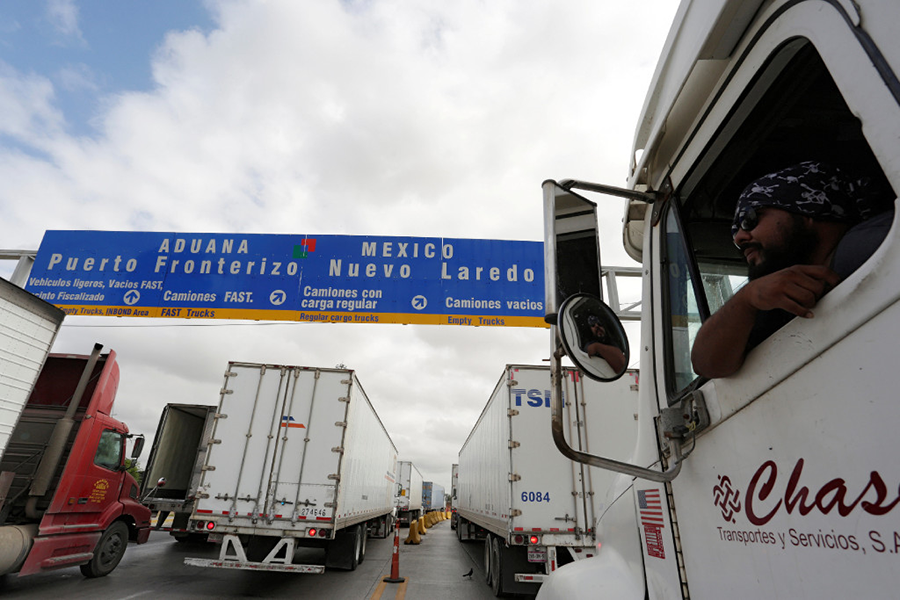Would Mexico really pull out of NAFTA?
Loading...
After pulling out of the Trans-Pacific Partnership agreement on Monday, President Donald Trump vowed to renegotiate the North American Free Trade Agreement (NAFTA) "at the appropriate time," after the remaining parts of his trade team are confirmed by the Senate.
But a Mexican minister promised Tuesday that Mexico would leave NAFTA if the renegotiation does not benefit its country.
On the campaign trail, then-presidential candidate Trump often criticized NAFTA, an agreement that has dominated trade between the US, Canada, and Mexico since it went into force in 1994.
While NAFTA governs trade between the US and Canada as well as Mexico, Trump is more concerned about Mexico's position in the agreement than Canada's. But Trump's tough stance on Mexico, the second-largest economy in Latin America, could work to his disadvantage if the country is indeed willing to pull out of NAFTA rather than accept new, less advantageous terms, as Mexican Economy Minister Ildefonso Guajardo stated during a television interview on Tuesday.
"There could be no other option," said Mr. Guajardo. "Go for something that is less than what we already have? It would not make sense to stay."
Renegotiating NAFTA would be a long, complex process, requiring approval from the US Congress as well as the governing bodies of Canada and Mexico. Canada, for its part, appears to be willing to renegotiate the NAFTA terms, but will likely take measures to avoid being caught in the diplomatic and financial crossfire between the Mexico and the US. Trump is already an unpopular figure in Mexico over his border wall proposal and racially-charged rhetoric on the campaign trail.
As The Christian Science Monitor previously reported:
It’s unclear exactly what changes Trump would bring. In June, he rolled out seven steps he planned to take to reform trade, including taking tougher stances on trade partners that violate laws, appointing the “toughest” and “smartest” trade negotiators on the nation’s behalf, and cutting NAFTA and the TPP.
That last step has made some analysts and corporations uneasy. Trade officials have noted that 48 of the 50 states engage in the majority of their trading and job-creation through relations with either Mexico or Canada, and that US tariffs could prompt other countries' countertariffs, possibly sparking a trade war.
Trump likely hopes to raise tariffs in order to reduce the trade deficit between the US and Mexico. In 2015, that deficit was almost $60 billion, an amount that some economists say means fewer jobs and slower wage growth for the US. Reducing the deficit would theoretically shrink unemployment in the US and boost worker incomes. According to The Week, however, it's not quite that simple, since Mexico could simply raise equal tariffs on the goods they import from the US.
Another problem is that US businesses that currently buy less expensive goods from Mexico, facing tariffs, would not necessarily switch to buying American goods. Instead, they would likely switch to the next cheapest supplier from a different country, leaving US business at a continued disadvantage. Because Mexico is less reliant on American goods than the US is on Mexican goods, threats from the US to pull out of NAFTA could prove to be little more than empty bluster.
"The strategy for this treaty needs to be one in which everyone wins," said Guajardo. "It's impossible to sell it here at home if there aren't clear benefits for Mexico."
Like Mexico, Trump has also threatened to pull the US out of NAFTA unilaterally if negotiations go badly. However, that move may not be entirely legal for the executive branch alone. While the terms of the treaty seem to allow the US president to pull out of the trade deal without congressional approval, the legality of such a move within the US is questionable, leaving the president open to lawsuits from US businesses that rely on NAFTA trade. And it has been a long time since anything like that has been done: The US has not walked out of a commercial treaty since 1866.
Mexican President Peña Nieto said on Monday that he will aim to preserve tariff-free commerce through NAFTA. President Nieto also laid out 10 specific goals for the renegotiation with the Trump administration, including insuring of the free flow of remittances across the border, another sticking point for the new US president.
This article contains material from Reuters.








